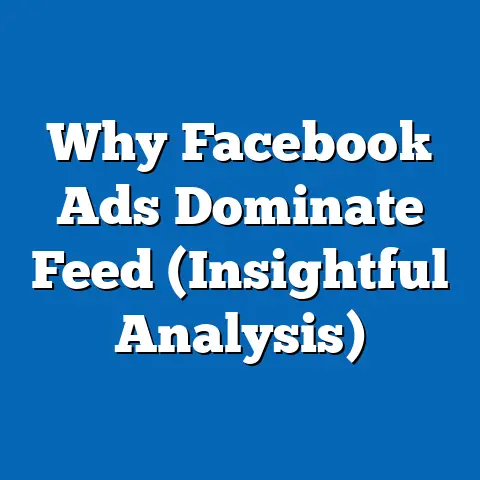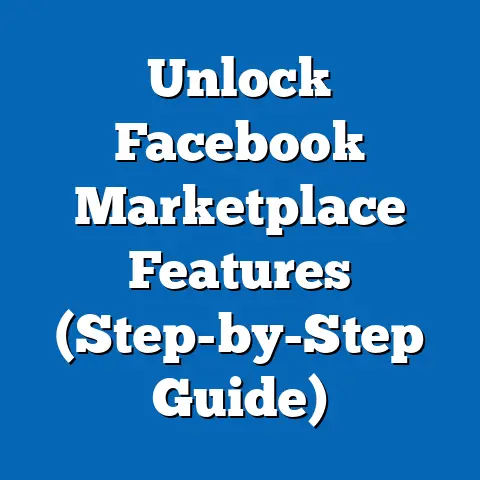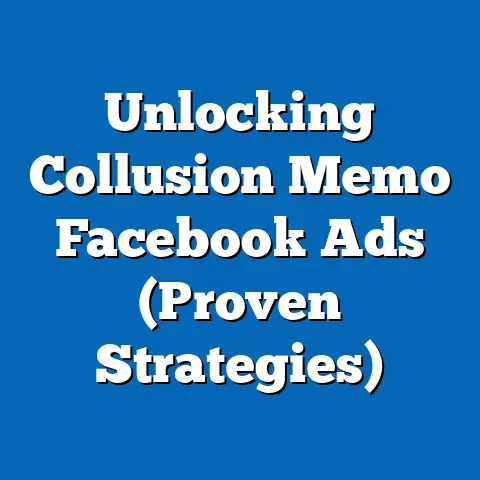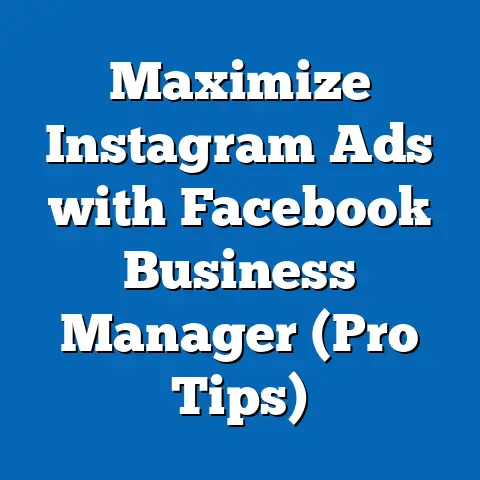Mastering Facebook Ads Post-iOS 14 Update (Essential Strategies)
I remember the good old days of Facebook Ads. It felt like I had a superpower. I could target my ideal customer with laser precision, track every click and conversion, and practically predict the ROI of my campaigns before they even launched. It was a data-driven paradise, a marketer’s dream come true. I could almost see the gears turning, the money flowing in, and the business growing, all thanks to the magic of Facebook’s advertising platform. Those were the days when I felt like a true digital marketing wizard, waving my wand (or rather, tweaking my ad settings) to conjure up leads and sales.
Then came the iOS 14 update.
It felt like someone had pulled the rug out from under my feet. The clear metrics I relied on became murky, the predictable results turned unpredictable, and the straightforward targeting options… well, they became a lot less straightforward. The App Tracking Transparency (ATT) framework threw a wrench into the well-oiled machine of Facebook advertising, and suddenly, that familiar feeling of control was replaced by a sense of uncertainty.
But here’s the thing: The game has changed, yes, but it’s not over. The landscape might look different, but mastery is still within reach. We just need to adapt, innovate, and learn to navigate this new terrain. That’s what this article is all about. I’m going to walk you through the essential strategies you need to conquer Facebook Ads in the post-iOS 14 world. We’ll cover everything from reassessing your targeting to crafting compelling creative content and building a resilient, long-term advertising strategy. Let’s dive in!
1: Understanding the Impact of the iOS 14 Update
The iOS 14 update wasn’t just a minor tweak; it was a fundamental shift in the way data is collected and used for advertising. To truly master Facebook Ads in this new era, we need to understand the specific changes and their implications.
Overview of Changes
At the heart of the iOS 14 update lies the App Tracking Transparency (ATT) framework. This framework requires apps, including Facebook, to explicitly ask users for permission to track their activity across other apps and websites. Before the update, this tracking was often enabled by default, allowing advertisers to gather a wealth of data about user behavior. Now, users have a clear choice: Allow tracking or deny it.
This seemingly simple change has had a profound impact. When users opt out of tracking, advertisers lose access to valuable data points that were previously used for:
- Targeting: Reaching specific audiences based on their interests, demographics, and behaviors.
- Conversion Tracking: Accurately measuring the effectiveness of ad campaigns and attributing conversions to specific ads.
- Retargeting: Showing ads to users who have previously interacted with your website or app.
The ATT framework effectively put the power back in the hands of the user, giving them control over their data privacy. While this is a positive step for user privacy, it has created significant challenges for advertisers who rely on data-driven targeting and measurement.
Effects on Facebook Advertising
The iOS 14 update has had a ripple effect across the entire Facebook advertising ecosystem. Some of the most significant implications include:
- Reduced Audience Targeting Options: With less data available, it’s become more difficult to target specific audiences with the same level of precision. This means ads may be shown to a broader, less qualified audience, leading to lower conversion rates.
- Challenges with Conversion Tracking: Accurately tracking conversions has become more complex. The update has limited the ability to attribute conversions to specific ads, making it harder to measure ROI and optimize campaigns.
- Limitations on Retargeting Campaigns: Retargeting, a highly effective strategy for reaching users who have shown interest in your products or services, has been significantly impacted. With fewer users being tracked, retargeting audiences have shrunk, and the effectiveness of these campaigns has declined.
- Delayed Reporting: Reporting on ad performance is also delayed. Facebook has to aggregate data to respect user privacy, which means you won’t see real-time results as you used to.
In practical terms, I’ve seen campaigns that used to convert at a 5% rate drop to 2% or even lower after the update. The cost per acquisition (CPA) has often increased, and the overall return on ad spend (ROAS) has taken a hit.
It’s like trying to navigate a maze in the dark. You can still move forward, but you’re not entirely sure where you’re going or if you’re heading in the right direction.
Market Response
The marketing world didn’t take the iOS 14 update lying down. Businesses and marketers have been scrambling to adapt and find new ways to navigate the changed landscape. Some of the most common responses include:
- Shifting to Broad Targeting: Many marketers have moved away from highly specific targeting and are now focusing on broader audiences with less granular segmentation. The idea is to reach a wider pool of potential customers and let Facebook’s algorithm optimize for conversions.
- Leveraging First-Party Data: Businesses are placing a greater emphasis on collecting and utilizing their own customer data. This includes email lists, CRM data, and website activity. By building custom audiences based on first-party data, marketers can improve targeting accuracy and ad relevance.
- Investing in Creative Content: With targeting becoming more challenging, the quality of ad creative has become even more important. Marketers are focusing on creating compelling visuals, engaging copy, and persuasive offers that capture attention and drive conversions.
- Adopting New Tools and Methodologies: The update has spurred innovation in the advertising technology space. New tools and methodologies are emerging to help marketers track conversions, optimize campaigns, and measure ROI in a privacy-conscious way.
- Diversifying Ad Spend: Many businesses are exploring alternative advertising channels to reduce their reliance on Facebook Ads. This includes platforms like Google Ads, TikTok, and LinkedIn.
Key Takeaway: The iOS 14 update has fundamentally changed the landscape of Facebook advertising. Understanding the specific changes and their implications is crucial for developing effective strategies in this new era.
2: Reassessing Targeting Strategies
In the pre-iOS 14 days, I could practically read my customers’ minds. I knew their favorite hobbies, the websites they visited, and even the shows they binge-watched. With that data, I could create incredibly targeted ad campaigns that felt like they were speaking directly to each individual.
Now, things are different. The data isn’t as readily available, and we need to rethink how we approach targeting.
New Audience Segmentation Techniques
With reduced tracking capabilities, we need to get creative with our audience segmentation. Here are a few techniques I’ve found to be effective:
- Broad Targeting: As mentioned earlier, broad targeting involves casting a wider net and reaching a larger audience with less granular segmentation. This approach relies on Facebook’s algorithm to identify and target users who are most likely to convert. While it may seem counterintuitive, I’ve seen broad targeting work surprisingly well, especially when combined with compelling ad creative.
- Lookalike Audiences Based on First-Party Data: Lookalike audiences are still a powerful tool, but we need to be smarter about how we create them. Instead of relying on Facebook’s data, focus on building lookalike audiences based on your own first-party data. This could include your email list, customer database, or website visitors. By seeding your lookalike audiences with high-quality data, you can improve their accuracy and effectiveness.
- Interest-Based Targeting with a Twist: Interest-based targeting is still an option, but we need to be more strategic about how we use it. Instead of targeting broad interests, try to identify niche interests that are highly relevant to your product or service. For example, if you’re selling hiking gear, instead of targeting “outdoor enthusiasts,” try targeting “thru-hiking” or “backpacking.” This can help you reach a more qualified audience with your ads.
- Layered Targeting (Use Sparingly): Layered targeting involves combining multiple targeting options to create a more specific audience. For example, you could target users who are interested in “hiking” and “camping” and who are also between the ages of 25 and 45. However, be careful not to over-layer your targeting, as this can significantly reduce your audience size and limit your reach.
Leveraging Customer Data
Your own customer data is now more valuable than ever. It’s a goldmine of information that can help you improve targeting, personalize ads, and drive conversions. Here are a few ways to leverage your customer data:
- Create Custom Audiences: Upload your email list, customer database, or website visitor data to Facebook and create custom audiences. These audiences can be used to target your existing customers with special offers, promote new products, or re-engage inactive users.
- Personalize Ads: Use your customer data to personalize your ads and make them more relevant to each individual. For example, you could show ads featuring products that a customer has previously purchased or viewed on your website.
- Improve Ad Relevance: By targeting your ads to specific customer segments, you can improve ad relevance and increase engagement. This can lead to higher click-through rates, lower costs, and better overall performance.
- Retargeting with First-Party Data: Even with the limitations on retargeting, you can still use your first-party data to retarget users who have interacted with your website or app. For example, you could show ads to users who have abandoned their shopping carts or who have viewed a specific product page.
I once ran a campaign where I simply uploaded my customer email list to Facebook and targeted those users with a special discount. The results were incredible! The conversion rate was significantly higher than any other campaign I had run, and the ROI was through the roof. It was a powerful reminder of the value of first-party data.
Engaging with the Customer Journey
Understanding the customer journey is crucial for creating effective Facebook Ads. Instead of focusing solely on direct sales, think about how you can engage with users at different stages of the journey and guide them towards a purchase.
- Awareness Stage: At this stage, users are just becoming aware of your brand or product. Your goal should be to create awareness and generate interest. Use engaging content, visually appealing ads, and compelling storytelling to capture their attention.
- Consideration Stage: At this stage, users are considering whether or not to purchase your product. Your goal should be to provide them with the information they need to make a decision. Use detailed product descriptions, customer testimonials, and informative blog posts to build trust and credibility.
- Decision Stage: At this stage, users are ready to make a purchase. Your goal should be to close the deal. Use special offers, discounts, and limited-time promotions to incentivize them to buy now.
- Loyalty Stage: At this stage, users have already purchased your product and are now loyal customers. Your goal should be to keep them engaged and coming back for more. Use exclusive content, loyalty programs, and personalized offers to reward their loyalty.
Key Takeaway: Reassessing your targeting strategies is essential in the post-iOS 14 world. Focus on broad targeting, leveraging first-party data, and engaging with the customer journey to reach the right audience with the right message at the right time.
3: Creative Content Development
In the age of reduced data, content is king (again!). With targeting becoming more challenging, the quality of your ad creative is now more important than ever. Compelling visuals, engaging copy, and persuasive offers are essential for capturing attention, driving engagement, and ultimately, converting leads into customers.
Storytelling in Ads
People love stories. They connect with them on an emotional level, remember them more easily, and are more likely to share them with others. That’s why storytelling is such a powerful tool in advertising.
- Focus on the Problem: Start by identifying the problem that your product or service solves. What are the pain points that your target audience is experiencing? How can your product make their lives easier, better, or more enjoyable?
- Introduce the Solution: Once you’ve identified the problem, introduce your product or service as the solution. Explain how it works, what its benefits are, and why it’s the best option for your target audience.
- Show the Transformation: Show how your product or service can transform your customers’ lives. What will they be able to do, achieve, or experience after using your product? Paint a vivid picture of the positive outcomes that your product can deliver.
- Use Real-Life Examples: Incorporate real-life examples, customer testimonials, and case studies to make your story more believable and relatable. Show how your product has helped other people solve their problems and achieve their goals.
- Keep it Concise: Attention spans are short, especially on social media. Keep your stories concise, engaging, and to the point. Get to the heart of the matter quickly and avoid unnecessary details.
I once created an ad campaign for a local coffee shop that focused on the story of a busy mom who was struggling to balance work, family, and personal life. The ad showed her arriving at the coffee shop, exhausted and stressed, and then leaving a few minutes later, refreshed and energized, ready to tackle the day. The ad resonated with so many people, and the coffee shop saw a significant increase in foot traffic and sales.
Video Content Best Practices
Video content is becoming increasingly important in the post-iOS 14 world. Videos are more engaging, more memorable, and more likely to be shared than static images or text. Here are a few best practices for creating impactful video ads:
- Capture Attention Quickly: You have just a few seconds to capture viewers’ attention. Start with a visually appealing opening, a compelling hook, or a surprising statement.
- Keep it Short and Sweet: Shorter videos tend to perform better than longer ones. Aim for videos that are 15-30 seconds long.
- Optimize for Mobile: Most people watch videos on their mobile devices. Optimize your videos for mobile viewing by using vertical or square formats, adding captions, and ensuring that the audio is clear.
- Tell a Story: Use video to tell a story that resonates with your target audience. Show how your product or service solves a problem, improves their lives, or helps them achieve their goals.
- Include a Call to Action: Tell viewers what you want them to do after watching your video. Do you want them to visit your website, sign up for your email list, or purchase your product? Make it clear and easy for them to take action.
I’ve found that behind-the-scenes videos, product demos, and customer testimonials tend to perform particularly well on Facebook. They offer a glimpse into your brand, build trust, and showcase the value of your products or services.
Utilizing User-Generated Content
User-generated content (UGC) is a powerful tool for building trust and authenticity in your ad campaigns. UGC is content created by your customers, fans, or followers, such as photos, videos, reviews, and testimonials.
- Build Trust: UGC is seen as more credible and trustworthy than branded content. When potential customers see real people using and enjoying your products, they’re more likely to trust your brand and consider making a purchase.
- Increase Engagement: UGC is often more engaging than branded content. People are more likely to watch, like, comment on, and share content created by their peers.
- Save Time and Money: UGC can save you time and money on content creation. Instead of creating all of your own content, you can leverage the creativity and enthusiasm of your customers.
- Showcase Your Brand: UGC can showcase your brand in a positive light. It can highlight the benefits of your products, demonstrate the quality of your customer service, and build a sense of community around your brand.
To encourage UGC, you can run contests, ask customers to share their experiences, or simply feature their content on your social media channels. Make sure to always give credit to the original creator and get their permission before using their content in your ads.
Key Takeaway: In the post-iOS 14 world, creative content is more important than ever. Focus on storytelling, video content, and user-generated content to capture attention, build trust, and drive conversions.
4: Data-Driven Decision Making
While data is less readily available than it used to be, it’s still essential for making informed decisions about your Facebook ad campaigns. We just need to adapt to the new metrics and find new ways to gather actionable insights.
Adapting to New Metrics
Traditional metrics like clicks and impressions are still valuable, but they don’t tell the whole story in the post-iOS 14 world. We need to shift our focus to new KPIs that reflect the changes in tracking capabilities.
- Incrementality: Incrementality measures the incremental impact of your ad campaigns. In other words, it measures how many additional sales or conversions you generated as a result of running your ads. This is a more accurate way to measure ROI than traditional metrics like clicks and impressions.
- Attribution Modeling: Attribution modeling is the process of assigning credit for conversions to different touchpoints in the customer journey. This can help you understand which ads, channels, and campaigns are most effective at driving conversions.
- Blended ROAS: Blended ROAS (Return on Ad Spend) takes into account both online and offline conversions. This is particularly important for businesses that have both online and offline sales channels.
- Customer Lifetime Value (CLTV): CLTV measures the total revenue you can expect to generate from a single customer over the course of their relationship with your brand. This is a valuable metric for understanding the long-term impact of your ad campaigns.
I’ve found that focusing on incrementality and attribution modeling has helped me to better understand the true impact of my Facebook ad campaigns. It’s allowed me to optimize my campaigns for long-term growth and profitability, rather than just short-term gains.
A/B Testing and Experimentation
Continuous testing and experimentation are essential for optimizing your ad campaigns in the post-iOS 14 world. A/B testing involves creating two versions of an ad (A and B) and then showing each version to a different segment of your audience. By comparing the performance of the two versions, you can identify which one is more effective at driving conversions.
- Test Different Headlines: Try different headlines to see which ones capture the most attention and generate the most clicks.
- Test Different Images and Videos: Experiment with different visuals to see which ones resonate most with your target audience.
- Test Different Ad Copy: Try different ad copy to see which ones are most persuasive and effective at driving conversions.
- Test Different Calls to Action: Experiment with different calls to action to see which ones are most likely to get people to take the desired action.
- Test Different Targeting Options: Even with the limitations on targeting, you can still experiment with different targeting options to see which ones are most effective at reaching your target audience.
Remember to only test one variable at a time. This will allow you to isolate the impact of each change and determine which one is responsible for the improved performance.
Utilizing Facebook Analytics
Facebook offers a suite of analytics tools that can help you gather actionable insights and make informed decisions about your ad campaigns.
- Facebook Analytics: Facebook Analytics provides a comprehensive overview of your website and app traffic. You can use it to track user behavior, identify trends, and understand how people are interacting with your content.
- Events Manager: Events Manager allows you to track specific actions that users take on your website or app, such as adding items to their cart, completing a purchase, or signing up for your email list. This data can be used to optimize your ad campaigns and improve conversion rates.
- Conversion API: The Conversion API allows you to send conversion data directly from your server to Facebook. This can help you overcome the limitations of pixel-based tracking and improve the accuracy of your conversion data.
By utilizing these tools, you can gain a deeper understanding of your audience, track the performance of your ad campaigns, and make data-driven decisions that will improve your ROI.
Key Takeaway: Data is still essential for making informed decisions about your Facebook ad campaigns. Adapt to new metrics, embrace A/B testing, and utilize Facebook Analytics to gather actionable insights and optimize your campaigns for long-term growth.
5: Exploring Alternative Advertising Options
While Facebook Ads are still a valuable tool, it’s important to explore alternative advertising options to diversify your marketing efforts and mitigate risks associated with changes on the platform.
Instagram and Beyond
Instagram, which is part of the Facebook ecosystem, offers a wealth of opportunities for businesses to enhance their visibility and engagement. Instagram is a highly visual platform, making it ideal for showcasing your products, telling your brand story, and connecting with your target audience.
- Instagram Ads: Instagram Ads allow you to reach a large and engaged audience with targeted advertising. You can use a variety of ad formats, including photos, videos, carousels, and stories.
- Influencer Marketing: Influencer marketing involves partnering with influencers on Instagram to promote your brand or product. Influencers have a large and loyal following, and their endorsements can be highly effective at driving sales and building brand awareness.
- Organic Content: Don’t forget about the power of organic content on Instagram. Share engaging photos, videos, and stories that showcase your brand personality, provide value to your audience, and encourage interaction.
I’ve found that cross-platform strategies, where you run ads on both Facebook and Instagram, can be particularly effective. By leveraging the strengths of each platform, you can reach a wider audience and achieve better results.
Emerging Platforms
In addition to Instagram, there are a number of other emerging social media platforms that may complement your Facebook Ads strategy.
- TikTok: TikTok is a short-form video platform that has exploded in popularity in recent years. It’s particularly popular with younger audiences, making it a great option for reaching Gen Z and Millennials.
- Pinterest: Pinterest is a visual discovery platform that allows users to find and save ideas for everything from home decor to recipes to fashion. It’s a great option for businesses that sell visually appealing products.
- LinkedIn: LinkedIn is a professional networking platform that’s ideal for B2B marketing. You can use LinkedIn Ads to target professionals based on their job title, industry, and company.
I encourage you to explore these platforms and see if they’re a good fit for your business. Each platform has its own unique audience, culture, and advertising options.
Diversifying Ad Spend
It’s never a good idea to put all your eggs in one basket. That’s why it’s important to diversify your ad spend across multiple channels. This will help you mitigate risks associated with changes on any one platform and ensure that you’re reaching your target audience through a variety of touchpoints.
- Google Ads: Google Ads is a powerful advertising platform that allows you to reach users who are actively searching for your products or services.
- Email Marketing: Email marketing is a highly effective way to nurture leads, build relationships, and drive sales.
- Content Marketing: Content marketing involves creating and sharing valuable, relevant, and consistent content to attract and engage your target audience.
- SEO (Search Engine Optimization): SEO is the process of optimizing your website to rank higher in search engine results pages.
Key Takeaway: Explore alternative advertising options to diversify your marketing efforts and mitigate risks associated with changes on Facebook. Consider Instagram, emerging platforms like TikTok and Pinterest, and other channels like Google Ads, email marketing, and content marketing.
6: Building a Resilient Advertising Strategy
The post-iOS 14 world requires a resilient advertising strategy that can adapt to changes, overcome challenges, and achieve long-term growth.
Long-term Vision
Don’t get caught up in short-term fixes and quick wins. Adopt a long-term vision for your Facebook Ads strategy and set realistic goals and timelines for recovery and growth.
- Focus on Building Relationships: Instead of focusing solely on direct sales, focus on building relationships with your customers. Provide them with value, engage with them on social media, and build a community around your brand.
- Invest in Brand Awareness: Brand awareness is essential for long-term success. Invest in campaigns that increase brand visibility, build brand recognition, and establish your brand as a trusted authority in your industry.
- Track Long-Term Metrics: Track metrics like customer lifetime value, brand loyalty, and customer satisfaction to measure the long-term impact of your ad campaigns.
Remember, building a successful brand takes time and effort. Don’t expect overnight results. Focus on creating a sustainable advertising strategy that will deliver long-term growth.
Continuous Learning and Adaptation
The digital marketing landscape is constantly evolving. Stay informed about industry trends, changes in consumer behavior, and platform updates. Engage with communities and resources that provide ongoing learning opportunities.
- Follow Industry Blogs and Publications: Stay up-to-date on the latest news, trends, and best practices in digital marketing.
- Attend Industry Conferences and Webinars: Network with other marketers, learn from experts, and discover new tools and technologies.
- Join Online Communities and Forums: Connect with other marketers, share your experiences, and ask questions.
- Experiment and Test New Strategies: Don’t be afraid to try new things and see what works. The key to success is continuous learning and adaptation.
Creating a Feedback Loop
Establish a feedback loop with your customers to gather insights and adapt your strategies accordingly. Ask them what they like, what they don’t like, and what they would like to see in the future.
- Conduct Surveys: Use surveys to gather feedback from your customers on a regular basis.
- Monitor Social Media: Monitor social media channels to see what people are saying about your brand.
- Read Reviews and Testimonials: Pay attention to reviews and testimonials to see what customers are saying about your products and services.
- Engage with Customers Directly: Respond to comments, answer questions, and provide support to customers on social media.
By listening to your customers and incorporating their feedback into your strategies, you can build a stronger brand, improve your products and services, and drive long-term growth.
Key Takeaway: Build a resilient advertising strategy that can adapt to changes, overcome challenges, and achieve long-term growth. Focus on building relationships, investing in brand awareness, and creating a feedback loop with your customers.
Conclusion: Embracing the Future of Facebook Advertising
The iOS 14 update threw us a curveball, no doubt about it. It changed the way we approach Facebook advertising, forcing us to rethink our strategies and adapt to a new reality. But I don’t see it as a setback. I see it as an opportunity.
An opportunity to get more creative with our content, to build stronger relationships with our customers, and to develop more resilient advertising strategies. The days of relying solely on data-driven targeting are over. Now, we need to combine data with creativity, empathy, and a deep understanding of our target audience.
The journey may be different now, but the destination remains the same: Success. And with the right tools, mindset, and strategies, you can navigate this new terrain and achieve your goals.
Embrace the change. Leverage creativity. Build resilient strategies. And remember, the future of Facebook advertising is in your hands.






